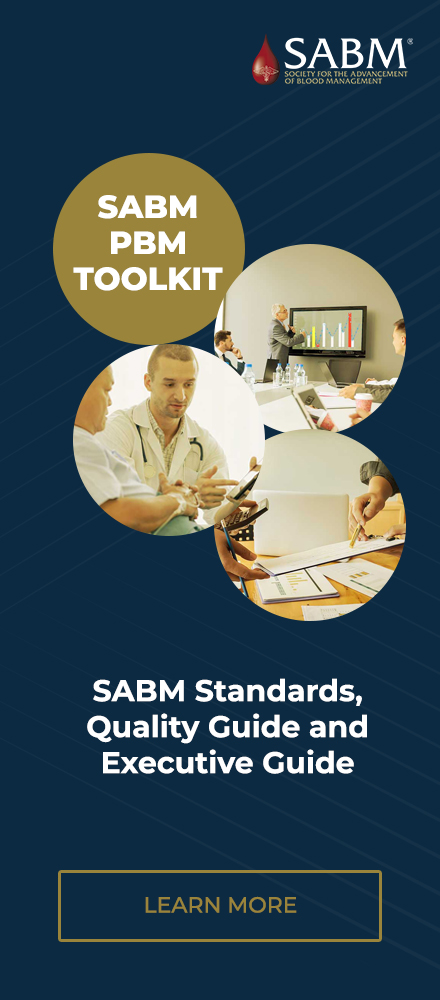MAY 2020
ISSUE

Please consider making a donation to your Society. Your donations will help us to improve the lives of people throughout the world through Patient Blood Management.
SABM 2020 Newsletter Publication
Editor: Kevin T. Wright
Associate Editor: Majed Refaai, MD
Contributors for This Issue
Christine Cahill, RN, MS
Ann Marie Gordon, PA-C, MLS (ASCP)
Beverly Khaek-On, BSN, RN
Mary Ann O'Brien, RN, MSN, CCRN, CNE
Sherri Ozawa, RN
Seth Perelman, MD, FASA
Majed Refaai, MD
Cassandra Upchurch, RN
Sarah Walbolt, BSN, RN
Kevin T. Wright
Marketing
Tim Bower, CAE
SABM Officers and
Directors
© 2020 Society for the Advancement of Blood Management
350 Engle Street Englewood, NJ 07631 USA Phone: (928) 551-6400 Fax: (877) 944-2272 EMAIL: [email protected] |
Continuing Education
Pre-operative Anemia Overview
Anemia is a hemoglobin (Hgb) concentration less than 13.0 g/dL in men and less than 12.0 g/dL in women as defined by the World Health Organization (WHO)[1] . It is estimated that an average of 5.6% of the US population are anemic[2] with certain populations being more susceptible to a high incidence of anemia, such as elderly hospitalized patients[3] and pregnant women[4,5] . In addition, almost one third of surgical patients were found to be at higher risk of developing anemia perioperatively[6] .
Causes of anemia may vary, decreased production of red blood cells (RBCs), increased destruction of RBCs, and/or blood loss. Iron deficiency is the most common cause and is frequently associated with bleeding, poor iron intake or absorption, or anemia of chronic disease. Folate and vitamin B12 deficiency are associated with poor diet or absorption disorders.
Evidence continues to emerge that preoperative anemia may be associated with a higher risk of postoperative morbidity and mortality. Normalization of Hgb has also been shown to reduce morbidity associated with anemia alone, in the absence of transfusion. Screening for anemia in the preoperative settings and providing the appropriate management and treatment before surgery may improve outcomes and reduce complications. Laboratory screening practices are slightly varied in the literature. Measurements of Hgb and hematocrit is often the first step in screening[7-16] . Some other tests useful in early anemia evaluation is mean corpuscular (MCV) to determine further patient workup after their initial anemia diagnosis. Often, when clinically appropriate, the patient should be referred for further evaluation to determine the cause of blood loss anemia[17] . Other screening algorithms use iron studies as the initial driver of an anemia evaluation instead of MCV and rely on serum ferritin (SF) and transferrin saturation (TSAT). Reticulocyte Hgb content (CHr) measures the iron content of developing red cells and reticulocytes. In the last few decades, CHr has been proven to be effective in detecting early iron deficiency anemia and therapeutic effect, particularly in children[18-20] .
Management and treatment of anemia is mainly based on cause. Iron deficiency anemia is commonly treated with oral iron supplementation due to ease of administration and cost, although, oral iron tends to have low bioavailability and can be poorly tolerated due to gastrointestinal side effects[21]. Lower once daily doses or every other day dosing has been shown to cause fewer gastrointestinal effects and improves absorption[22-24]. Oral replacement is not ideal for surgical patients since repletion of iron stores may take up to 3-6 months[25].
A more feasible option for treating preoperative anemia in surgical patients with time constraints is intravenous (IV) iron infusions[8] . IV iron improves Hgb quickly and effectively exhibiting a Hgb response within 5 to 14 days[26] . According to the latest literature, studies using IV iron dosed a week apart showed an effective approach in treating iron deficiency anemia[27] .
Recent evidence has shown benefit of using erythropoietin (EPO) and IV iron together. The iron replacement in this case may reduce the EPO-induced functional iron deficiency while also reducing blood transfusion requirements[8]. One study found reduced transfusion risk with administration of iron and EPO compared to iron alone, as well as no increased risk of mortality, stroke, myocardial infarction, renal dysfunction, pulmonary embolism, or deep vein thrombosis[28] . Another recent meta-analysis demonstrated preoperative EPO can improve Hgb levels and reduce blood transfusions in patients undergoing elective hip or knee orthopedic surgeries[29] as well as patients undergoing cardiac surgeries[30] . Safety is a concern with utilizing EPO in treating preoperative anemia due to the increased risk of thromboembolic events. These risk can be mitigated using lower doses and shorter duration[29] . Nevertheless, several meta-analyses found no increased risk of serious adverse or thromboembolic events[27,30] . Cost is another barrier and in some cases insurance reimbursement can be difficult to obtain[31] .
Anemia is a common medical problem that for years had minimal impact on the decision to proceed with elective surgery with the thought that minor anemia could easily be corrected with allogenic blood transfusion. As medicine has advanced, anemia is now considered a significant predictor of postoperative morbidity and mortality. With the currently improved therapy available, preoperative anemia optimization is a major component of a comprehensive PBM program, and a recent systematic review of 17 studies demonstrated that these types of programs may result in decreased transfusion requirements, complications, and mortality rates[32] .
Contributors: Christine Cahill, RN, MS, and Majed Refaai, MD
References
Blood Bank Guy
SABM continues its ongoing relationship with Dr. Joe Chaffin/TheBloodBankGuy. Two SABM members were featured recently: Carolyn Burns, MD, addressed the question: “Hospital Transfusion Committees: Effective or a Necessary Evil?” Joseph Sweeney, MD, addressed the question: “Does That Patient REALLY Need Platelets?” Log in @ www.bbguy.org. These podcasts provide CME credits.
|




Consider submitting your future manuscripts in PBM for peer review and publication in this new section. The success of this endeavor will depend on the provision of material to make it lively and attractive to our colleagues and other professionals in the field.
Members Invited to Submit Papers CLICK HERE
|